
32
TẠP CHÍ KHOA HỌC
Khoa học Tự nhiên và Công nghệ
Lo Ngoc Dung* and Nguyen Thi Thuy An (2024)
(32): 32-37
THEORETICAL INVESTIGATION OF THERMODYNAMIC PROPERTIES
OF SAMARIA-DOPED CERIA
Lo Ngoc Dung* and Nguyen Thi Thuy An
Tay Bac University
Abstract: The thermodynamic properties of Samaria-doped Ceria (SDC) are investigated using statistical
moment method. The explicit expressions of thermal expansion coefficient and heat capacities at constant
pressure and volume are derived including the anharmonicity effects of lattice vibrations. This study finds
the dependences of the thermal expansion coefficient and heat capacities on temperature and dopant
concentration. Our results are compared with experimental data.
Key words: Thermodynamic properties, Samaria-doped Ceria, Statistical moment method.
1. INTRODUCTION
Ceria (CeO2) is the interesting subject due to
its application in catalysis, electrolyte materials,
gas sensor, and resistive random access
memory [1-4]. Samaria-doped Ceria (SDC)
crystal in the cubic fluorite structure (space
group Fm3m), is created by aliovalent doping
with Sm3+ ions, which substitute Ce4+ ions on
the face-centered cubic (fcc) cation lattice.
Insertion of the lower valent cations Sm3+
creates high concentration oxygen vacancies
according to Eq. (1) with the Kröger -Vink
notation [5]
' x ••
2 3 Ce O O
Sm O 2Sm 3O V
Many experimental and theoretical studies have
been carried out on the thermodynamic properties
of SDC crystal [6,7]. G. Neilsen et al. [6]
measured the heat capacity of CeO2 doped Nd or
Sm samples with dopant concentrations x = 0.047 -
0.154. They reported the thermodynamic functions
based on theoretical fits
0 0 0
p,m m m
, , ,C S H
and
0
m
of measured data. Here,
0
p,m
C
is the heat capacity at
constant pressure,
0
m
S
is molar entropy,
0
m
H
is
molar enthalpy, and
0
m
is Gibss-energy based
Massieu potential. T. Hisashige et al. [7] found the
thermal expansion and Debye temperature of pure
CeO2 and rare earth-doped CeO2 using an
ultrasonic pulse method. They showed that the
thermal expansion coefficient of rare earth-doped
CeO2 increase with the increasing of dopant
concentration and is larger than that of pure
CeO2.
Previously, statistical moment method (SMM)
has been used to investigate diffusion and
electrical properties of SDC crystal [8,9]. In this
paper, we use SMM to calculate the
thermodynamic quantities of SDC crystal.
Compared with other theoretical methods, the
SMM gives mathematically simple with
comprehensive descriptions of the characteristic
properties of crystal lattice. The calculated results
reveal the dependences of the thermal expansion
coefficient and heat capacities on temperature and
dopant concentration.
2. THEORY
The general formula of SDC crystals taking
into account the presence of oxygen vacancies
is Ce1-xSmxO2-x/2, where x is the concentration
of Sm3+ ions.
In the SMM, Ce1-xSmxO2-x/2 crystals are
charactered by the anharmonic vibrations of Ce4+,
Sm3+, and O2- ions with the force constants
Ce Sm O
,,
k k k
the vibration frequencies
Ce Sm O
,,
,
and the anharmonic parameters
,
Ce
1,
Sm
1,
O
1,
Ce
2,
Sm
2,
O
2,
Sm ,
O
[8].
*2
Ce,Sm,O Ce,Sm,O
2 Ce,Sm,O
0
2
1,
2
j
jjeq
km
u
(1)

33
O
0
32
O
O
eq
1,
23
j
jj j j
k
u u u
(2)
Ce,Sm,O
0
4
Ce,Sm,O
14
eq
1
48
i
jj
u
(3)
Ce,Sm,O
0
4
Ce,Sm,O
222
eq
1
8
j
jjj
uu
(4)
Ce,Sm,O Ce,Sm,O
Ce,Sm,O 1 2
4
(5)
where
= x, y or z,
,
jj
uu
are Cartesian
components of the ionic displacement of jth
ion,
Ce
jo
(or
Sm
jo
or
O
jo
) is the interaction
potential between 0th and jth Ce4+ (or Sm3+, or
O2-) ions, and m is the average ionic mass.
The Helmholtz free energy of
Ce1-xSmxO2-x/2 crystal is given by [8, 9]
2 /2
Ce *
Sm Sm 0
x
CeO c
N u TS
(6)
where
Sm
and
Ln
N
are total Helmholtz
energy and the number of Sm3+ ions,
respectively, in Ce1-xSmxO2-x/2 crystals,
*
c
S
is the
configurational entropy of this crystal, and
Ce
0
u
is the average interaction potential of a Ce4+ ion
in Ce1-xO2-x/2 crystal that determined through the
Helmholtz free energies of Ce4+ and O2- ions
[10].
In the SMM, the Helmholtz free energies of
Ce4+, Sm3+ and O2- ions can be written as [8, 9]
Ce
2
Ce
Ce
Ce 0 Ce
3 ln 1 s
E N es
Ce
2
Ce 2 Ce
1
2 Ce 1
2
Ce
Ce
2
33
Na
kS
3 Ce 2
Ce
1
2 Ce
4
Ce
24
3
a
kS
2
Ce Ce Ce
1 1 2 Ce
2 2 1 ,
S
(7)
Sm
2
Sm
Sm
Sm 0 Sm
3 ln 1 s
E N e
s
Sm
2
Sm 2 Sm
1
2 Sm 1
2
Sm
Sm
2
33
Na
kS
3 Sm 2
Sm
1
2 Sm
4
Sm
24
3
aX
k
2
Sm Sm Sm
1 1 2 Sm
2 2 1 ,
X
(8)
O
2
O
O
O 0 O
3 ln 1 s
E N es
O
2
O 2 O
1
2 O 1
2
O
O
2
33
Na
kS
3O 2
O
1
2O
4
O
24
3
a
kS
2
O O O
1 1 2 O
2 2 1
S
O
O
O
31
6
k
N
1
OO
O
22
O 1 O 1
1
3 2 3
2
3 9 9
a k a
a
O
O1
O
3
O
1
96 ,
ka
kS
(9)
Ce,Sm,O
Ce,Sm,O 2,
s
Ce,Sm,O
Ce,Sm,O
11,
2
S
a
Ce,Sm,O Ce,Sm,O Ce,Sm,O
coth ,S s s
where
B,kT
B
k
is the Boltzmann
constant,
Ce,Sm,O
is the vibrational frequencies
of ions, is the Planck constant and
Ce
0
E
,
Sm
0
E
,
O
0
E
are the total interaction potentials of Ce4+,
Sm3+, and O2- ions at the equilibrium position,
respectively.
The average ion displacements of Ce4+,
Sm3+, and O2- ions from the equilibrium
position at temperature T are given by [8,9]
2
Ce,Sm
Ce,Sm Ce,Sm
3
Ce,Sm
2
3
y T A
k
(10)

34
2 2 2
OO
OO
34
OO
26
11x
33
yA
k
2
O
O
2
O O O
12
x 1 ,
3 3 27
X
kk
(11)
where
Ce,Sm
A
and
O
A
are determined as in
Refs. [10] and [11].
The average nearest-neighbor distance at
temperature T can be written as
1 1 Ce Ce
Sm Sm O O
( ) 0 ( )
( ) ( ).
r T r c y T
c y T c y T
(12)
The definition of the thermal expansion
coefficient enables us to derive the fomula
[10,11]
Ce Ce Sm Sm O O
()
( ) ( ) ( )
T
c T c T c T
(13)
with
Ce Sm O
,,c c c
denote the concentration of
Ce4+, Sm3+ and O2- ions, respectively, and
Ce,Sm,O
B
Ce,Sm,O
1
()
() 0
yT
k
Tr
(14)
The heat capacities of Ce4+, Sm3+ and O2-
ions at constant volume
Ce Sm O
V V V
,,C C C
can be
defined from the partial free energies of ions
Eq. (7) – Eq. (9). Then, the heat capacity at
constant volume can be written as [10,11]
Ce Sm O
V Ce V Sm V O V
C c C c C c C
(15)
with
2
Ce Ce
V2,
CT
T
2
Sm Sm
V2,
CT
T
2
OO
V2
CT
T
The heat capacity at constant pressure is
calculated based on the relation as [10,11]
2
P V T
9C C B VT
(16)
here,
T
B
denotes the bulk modulus of SDC
crystal.
3. NUMERICAL RESULTS AND
DISCUSSION
To describe the interionic interaction in
doped ceria oxides, one often employs the pure
Coulomb potential and Buckingham potential
including the short-range interactions as [12]
6,
mn
m n mn
mn mn
r
B
q q C
rA
rr
e
(18)
where qm, qn are the effective charges of the
mth and nth ions, r is the separation between
ions, and the potential parameters Amn, Bmn,
Cmn are presented in Table 1.
Table 1. The parameters of the Buckingham
potential in SDC crystal [12].
Interaction
eV)(
mn
A
o
A)(
mn
B
o6
A.
()
mn eV
C
O2- - O2-
9547,96
0,2192
32,00
Ce4+ - O2-
1809,68
0,3547
20,40
Sm3+ - O2-
1944,44
0,3414
21,49
Fig. 1 shows the lattice constant of SDC
crystal at the room temperature as a function of
dopant concentratrion.
Figure 1. The dopant concentration dependence of
lattcice constant at T = 300 K. The experimental
results [13-16] is shown for comparison.
One can see that the lattice constant is little
larger than that of CeO2 crystal (x = 0). As the
dopant concentratrion increases, an increase in
the lattice constant is found. The lattice expansion
due to doping arises from the larger radius of
Sm3+ ions compared with that of Ce4+ ions. Our
theoretical calculations are in good accordance
with experiments [13-16]. The experimental
results [15,16] increase rapidly with an increase
in dopant concentration at x
0.2 but vary more
slowly as the dopant concentration comes close to
the solubility limit, x = 0.4.
The calculated results of thermal expansion
coefficient of SDC crystal at 600 K are presented
in Fig. 2. One can see that the thermal expansion
coefficient increases linearly with the increasing
of dopant concentration. This dependence reveals

35
the larger value of thermal expansion coefficient
of SDC crystal in comparison with that of CeO2
crystal. The substitution Ce4+ ions by Sm3+ ions
promotes the thermal vibration of ions and
therefore, the ions vibrate stronger due to
temperature. The meased results using Rigaku
Thermo Plu TMA [17] is also shown in Fig. 2.
Our obtained SMM thermal expansion
coefficients are in relatively good with the
experimental data [13]. The errors are only about
3 – 5 %.
Figure 2. The dopant concentration dependence of
thermal expansion coefficient at T = 600 K. The
experimental results [17] is shown for comparison.
Fig. 3 presents the SMM results of thermal
expansion coefficient of SDC crystal at the
dopant concentration x = 0.2. The thermal
expansion coefficient is shown as a function of
the dopant concentration. The thermal expansion
coefficient increases as the temperature increases.
Notably, the thermal expansion coefficient rises
quickly in the high temperature range, T > 2000
K. This property arises from the anharmonicity
effects of thermal lattice vibrations. T. Hisashige
et al. [18] measured the thermal expansion
coefficient of SDC crystal at x = 0.2 using X-ray
powder diffractometer. The obtained data is very
close with the SMM results.
Figure 3. The temperature dependence of thermal
expansion at x = 0.2. The experimental results [17]
is shown for comparison.
In Fig. 4, the calculated results of heat
capacities at constant volume CV and pressure
CP are presented. One can see that the heat
capacity at constant volume CV depends weakly
on temperature, but the heat capacity at
constant pressure CP changes quickly with
temperature and becomes a nonlinear function
of temperature.
Figure 4. The temperature dependence of heat
capacities in the temperature range T = 100 – 2000
K at x = 0.2.
The strongly anharmonic lattice vibration
under high temperture is the principal reason
for the anomalous increase of the heat capacity
at constant volume CV near melting
temperature. This property is also found in
metallic materials, such as Cu, Pd, Ag, … [18].
The heat capacities at the different dopant
concentrations (x = 0.1; x = 0.2) show the
dopant concentration dependence of the heat
capacities. The heat capacities become larger as
the dopant concentration increases.
4. CONCLUSION
In this paper, the SMM model is used to
investigate the thermodynamic properties of SDC
crystal. The thermal expansion coefficient and
heat capacities are calculated as a function of
dopant concentration and temperature. The
anomalous increase of thermal expansion
coefficient and heat capacity at constant volume
near melting temperature arises from the strongly
anharmonic lattice vibration. Our results are
compared with the experimental data.
ACKNOWLEDGMENTS
This research is funded by Tay Bac
Universiy.

36
REFERENCES
[1] R. Di Monte, J. Kaspar (2004), On the
Role of Oxygen Storage in Three-Way
Catalysis, Topic in Catalysis 28, pp. 47-57.
[2] M. Sugiura, O. Masakuni, S.
Akihiko, S.Tadashi(2005), Developement of
Innovative Three-Way Catalysts Containing
Ceria–Zirconia Solid Solutions with High
Oxygen Storage/Release Capacity, Catal. Surv.
Asia 78 (5), pp. 752-767.
[3] S. Bernal, G. Blanco, J.J. Calvino, J.M.
Gatica, J.A. Perez-Omil, J.M. Pintado (2004),
Characterisation of three-way automotive
aftertreatment catalysts and related model
systems, Top. Catal. 28 (1-4), pp. 31-45.
[4]J. Kaspar, P. Fornasiero (2003),
Nanostructured materials for advanced
automotive de pollution catalysts, J. Solid State
Chem. 171, pp. 19-29.
[5] M. Coduri, S. Checchia, M. Longhi,
D.Ceresoli, M. Scavini (2018), Rare Earth
Doped Ceria: The Complex Connection
Between Structure and Properties, Front. Chem.
6, pp. 526-1-526-23.
[6] G. Neilsen, P.F. Rosen, M.S. Dickson,
M. Popovic, J. Schliesser, L.D. Hansen, A.
Navrotsky, B.F. Woodfield (2021), Heat
capacities and thermodynamic functions of
neodymia and samaria doped ceria, J. Chem.
Thermodynamics 158, pp. 106454.
[7] T. Hisashige, Y. Yamamura, T. Tsuji
(2006), Thermal expansion and Debye
temperature of rare earth-doped ceria, Journal
of Alloys and Compounds 408, pp. 1153-1156.
[8] L. T. Lam (2022), Effects of temperature
on the electrical properties of samaria-doped
ceria predicted with the statistical moment
method, Journal of Physics and Chemistry of
Solids 170, pp. 110907.
[9] D. T. Hai, V. V. Hung, P. N. Thu, L. N.
Dung, L. T. T. Huong, H. T. M. Anh, L. T.
Lam (2022), Structural and Electrical
Properties of Samarium-doped Ceria
Electrolyte, VNU Journal of Science:
Mathematics – Physics 38 (1), pp. 65-75.
[10] V.V. Hung, L.T.M. Thanh, K. Masuda-
Jindo (2010), Study of Thermodynamic
Properties of Cerium Dioxide under High
Pressures, Comp. Mater. Sci. 49 (4), pp. S355-
S358.
[11] V. V. Hung, J. Lee, K. Masuda-Jindo
(2006), Investigation of Thermodynamic
Properties of Cerium Dioxide by Statistical
Moment Method, J. Phys. and Chem. Solids 67
(4) , pp. 682-689.
[12] L. Minervini, R. W. Grimes, K. E.
Sickafus (2000), Disorder in Pyrochlore
Oxides, J. Am. Ceram. Soc. 83 (8), pp. 1873-
1878.
[ 13] S. Zha, C. Xia, G. Meng (2003), Effect
of Gd (Sm) Doping on Properties of Ceria
Electrolyte for Solid Oxide Fuel Cells, Journal
of Power Sources 115 (1), pp. 44-48,
[14] Z. Fu, Q. Sun, D. Ma, N. Zhang, Y. An,
Z. Yang (2017), Effects of Sm Doping Content
on the Ionic Conduction of CeO2 in SOFCs
from First Principles, Appl. Phys. Lett. 111 (2),
pp. 023903-1-023903-5.
[15] K. Eguchi, T. Setoguchi, T. Inoue, H.
Arai (1992), Electrical Properties of Ceria-
Based Oxides and Their Application to Solid
Oxide Fuel Cells, Solid State lonics 52 (1-3),
pp. 165-172.
[16] Z. Zhan, T. -L. Wen, H. Tu, Z. -Y. Lu
(2011), AC Impedance Investigation of
Samarium-Doped Ceria, Journal of The
Electrochemical Society 148, pp. A427-A432
[17] T. Hisashige, Y. Yamamura, T. Tsuji
(2006), Thermal expansion and Debye
temperature of rare earth-doped ceria, Journal
of Alloys and Compounds 408, pp. 1153–1156
[18] K. Masuda-Jindo, Vu Van Hung, and
Pham Dinh Tam (2003), Thermodynamic
quantities of metals investigated by an analytic
statistical moment method, Physical Review B
67, pp. 094301.




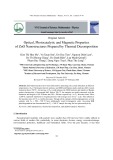
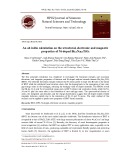
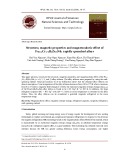


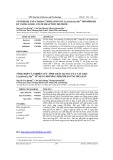









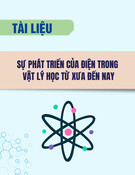
![Bộ câu hỏi lý thuyết Vật lý đại cương 2 [chuẩn nhất/mới nhất]](https://cdn.tailieu.vn/images/document/thumbnail/2025/20251003/kimphuong1001/135x160/74511759476041.jpg)
![Bài giảng Vật lý đại cương Chương 4 Học viện Kỹ thuật mật mã [Chuẩn SEO]](https://cdn.tailieu.vn/images/document/thumbnail/2025/20250925/kimphuong1001/135x160/46461758790667.jpg)




